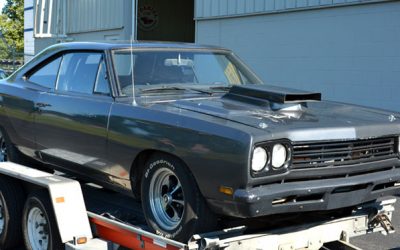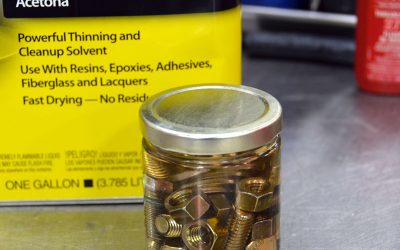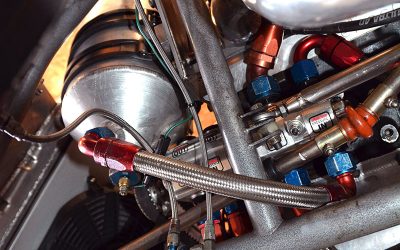Racing exists in so many forms it’s impossible to consider every question about every application every time. There are specialty categories from karting to blown nitromethane… from mud and dirt to high speed road courses to tractor pulling (although in the unlimited pulling categories you’d be hard pressed to identify the machine as a tractor if you didn’t recognize the rear tires!)
There are stock engines that are adapted or extensively modified and there are bespoke engines created from a clean sheet, like the Offenhausers or Cosworths, designed to do a particular job in a particular application. Some of your best options are engines with design characteristics borrowed from stock designs that are highly refined and improved from companies like Dart, World, Donovan or Brodix. Which you choose depends on the rules and your wallet, but in my opinion you are much, much better off with a quality product from companies like those I listed above than with trying to make a stock block work. With an aftermarket block you can buy a priority main oiling system with more deck height, more bore centerline spacing (if you need it) and a wider pan rail, internally clearanced at the manfacturer for long strokes for relatively little money, making building larger displacements easier and resulting in a more durable final product.
Back in the Bad Old Days
Stock blocks were all we had back in the day and we broke a ton of them as power levels came up. They were too thin, with or without core shift; the oiling maps were a compromise and the quality too variable. Today’s engines are much better and you can certainly build a fair amount of power with the superior construction of a modern stock engine block, but above about 750 horsepower you’re still going to end up with more distortion and higher failure rates than with a quality aftermarket block designed for racing. I know the magazines all love to talk about their latest 1000 (the latest “magic†number) horsepower stock block engine, but you’ll note that you don’t read any follow up stories about how it’s still running a year or two later with two to five hundred full throttle passes on it. And let’s be honest, making a thousand horsepower on the dyno for a four or five pulls, in a controlled environment, with a cam specifically ground to jack the number up while destroying the valve train isn’t real world, is it? It’s why we race cars, not dynos….
Know Your Goals
For me, it starts with what you want to do. What is the class of competition, the vehicle type, your available funding and the purpose and goals of your racing endeavor? It’s tempting to just say “dominate my category of racing to such an extent that every competitor drops out at the mere mention of my name†but that’s not likely, is it?
Most racers I know start at one point and over time graduate into the highest level of racing that they have the time and money to support, in many cases slowly rebuilding or modifying their vehicles to take advantage of what they already own and are familiar with. This can be good in that a racer slowly learns the skills needed and it conserves resources but it’s also bad because at some point the old architecture of the car won’t support your increased power levels without massive changes and expense. The point is that if you intend to advance in the sport at some point you leave the world of stock-based cars and engines behind and go to tube chassis cars with racing developed heads, blocks and accessories that make going faster easier and safer. A quick word to the wise about safety; driver safety is often an afterthought, but crew chief or driver, you’ll be glad you thought about it if an axle shears or a tire gets cut down at a hundred and fifty.
Before someone gets excited about it, this is no way diminishes the dedicated stock or super stock racer who has kept his first car for forty years and slowly pushed the record! Working within the highly restrictive rules of stock and super stock racing while shaving a few hundredths off the record every year is a feat just as worthy of recognition as the Top Fuel pilot who (eventually) cracks 340 miles per hour!
The Rules
Once you have your goal established, read the rule book. Read it a lot and write down all the parts that you need to pay real attention to. Read what it says you HAVE to do… the limits and restrictions… and pay particular attention to what is unlimited or unaddressed. Weight, wheelbase, construction type and power levels put you inside a “performance box†and those options that are unlimited or unaddressed let you optimize where in the box your little monster lives. If you’re creative enough you might even end up redrawing the boundaries of the box!
With all this in mind let’s review where we start, and that’s with bore, stroke, cylinder heads, flow rates, power adders, weight and required power levels to achieve your ET and MPH goals for the class you’ve landed on.
Displacement sets air flow requirements and air flow is limited by cylinder head, intake and exhaust design. Bore sets valve diameters since too large a valve in too small a cylinder results in excessive bore shrouding which makes the valve appear undersized for the application if air flow is disrupted. Power adders like nitrous and blowers change the optimum intake/exhaust valve ratios, because filling the cylinder when naturally aspirated requires that you bias to a larger intake size and adders make intake a little less important while increasing the need to bias more toward a larger exhaust valve, so knowing this BEFORE you order your parts is critical. Alcohol and high flow multi-stage nitrous systems also impacts overall intake and port volume requirements. One can’t move air if there’s something else in the air stream, and no matter how cold it is or how much density increase you get you’ve still only got so much “pipe†feeding the bore. Of course both alcohol and nitrous are oxygen bearing, but volume taken up by fuel is still volume unavailable for air.
Plan Ahead, Think Ahead
Thinking ahead saves you time, money and effort. Reactive thinking costs you and can result in a combination of parts that will never hit your power level requirements. There’s no worse feeling in the world than buying parts that cannot and will not work and being forced to take a financial bath selling them for half what you paid for them. My best advice is to grab a piece of paper and write down what you’re doing and where you want to end up before you order the first part.
In general (a very dangerous word in racing…) you figure out displacement, go with the largest bore possible to fit the largest total valve diameters possible, adjust the stroke to get your displacement and buy the cylinder head with the air flow number that supports your power level with the correct intake to exhaust valve ratio for your application. Buy the lightest components you can on the valve side of the rocker and the strongest components you can on the lifter side of the rocker. While you’re thinking about it, try to buy “off-the-shelf†components rather than custom made stuff. Find a combination of stroke, rod length and piston compression height you need to hit your deck height that you can buy from the catalog rather than design something that requires a special order with a three month waiting period.
Cylinder heads come in a hundred varieties, from near stock to racing designs that roll the head around its longitudinal axis to reduce chamber volume and move the valves away from the bore wall as well as custom options that cant the valves in toward the bore centerline. Of course if the “ceiling†of the bore is changed that dictates that there is a corresponding change to the “floor†of the bore, so the piston must match the head. Pistons should be as light and short as possible and still control the ring pack.
Rolled heads with raised or custom port locations also require special intake manifolds and exhaust systems, so keep that in mind if you’re working with an existing chassis or car with clearances limited by existing structure. If you have to cut out and move the front chassis tubes or buy a different hood that just adds to the pain. If I were starting off clean sheet I’d search every racing head manufacturer and porter and talk to as many as would answer the phone and then compare notes to see if everyone is telling me roughly the same story. When you buy heads today there are dozens and dozens of really good options and a lot of five axis CNC’d heads out there for reasonable money. Cylinder heads is one area where you will spend the right amount of money to get the best and probably nearly half your engine budget will go to heads and valve train. Also try to keep in mind that you’ll want to be able to get your valve train components off the shelf from folks like Jesel or T and D.
Good Parts Aren’t Cheap; Cheap Parts Aren’t Good
When you shop and price the reciprocating components something to remember is to verify the country of origin for the casting or billet material. There are still good American forgings available and the quality companies using them all get them from the same sources. Prices tend to vary, but that’s not due to the materials as much as it’s due to workmanship. What you’re paying for is the quality of the machining, the amount of weight removed, the balancing style and the surface finishes. Properly done the surface finish of a racing crankshaft should look like a mirror. Expect to pay about $2000 for a quality crankshaft and $5000 or more for a billet. Connecting rods fall into much the same category. Companies like Callies, Oliver, Carillo, Dyer, GRP, Bill Miller and Crower have top shelf product and the little you save going off shore will surely come back to haunt you as you push your power levels up. Most quality connecting rod suppliers also have rod bolt options and you can upgrade to a better bolt if you need the additional tensile strength. Don’t get me wrong, off shore bits work great for street or moderate power levels… but if you’re over 750 horsepower, start looking for better parts.
The last couple of things we’ll look at are build and oiling systems. There’s no such thing as a fixed set of specifications for any given engine. As power levels increase, the clearances are increased because with more power comes more deflection, bending and bowing and the extra clearance keeps parts from pushing through the oil film and galling. Where a street engine might use .0008-.0015†for bearing clearance a Top Fuel car might be running with .006-.0075†and they are using the stiffest and strongest components made. I guess if you’re making 1250 horsepower per bore even the best parts need a little help in the form of extra clearance. The valve guide, piston to bore, piston pin and rod side clearances all get wider with increased power. Talk to your parts supplier and to other racers using similar components and developing similar power to find a good starting point, but if you have to err, err on the loose side. Live loose, die tight!
With this increased clearance comes an increased demand for oil volume which can only be met by going to a dry sump oiling system. The effectiveness of a traditional wet sump with the oil pump in the pan like those used on production vehicles is limited by the movement of the oil in the pan on acceleration (the oil stands up on the back wall) and the quantity and depth of oil available to keep the pickup from drawing air. The dry sump system uses several scavenging sections to recover the oil, after which it’s sent to a specially designed tank where it’s de-aerated and stored until it’s pumped out by a high volume, adjustable pressure pump to the engine through external plumbing. The high leak rates through the bearings caused by large clearance aren’t a problem to manage with flow rates developed by a dry sump system.
Building a racing engine is an expensive proposition. Using the wrong parts for the application or trying to “save your way to victory lane†just makes it more expensive. You can’t save enough using cheap parts to ever make up for blowing up… buy good parts, good fuel and good safety equipment and have fun. It’s why we do it, right?





0 Comments